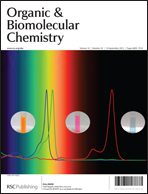Inter- and intrastrand DNA crosslinks by 2-fluoro-substituted pyrrolobenzodiazepine dimers: stability, stereochemistry and drug orientation†
Abstract
A 2-fluoro-substituted pyrrolo[2,1-c][1,4]benzodiazepine (PBD) dimer with a 1,4-di-n-propyl piperazine linker was studied with respect to its binding and crosslinking capability towards double-helical DNA targets. Duplex thermal stabilizations upon drug binding as measured by UV melting experiments suggest that two guanine bases separated by four AT base pairs constitute the favorable binding site for the PBD dimer. Large stabilizations were observed for the self-complementary duplex d(AACAATTGTT)2 as well as for the non-self-complementary duplex d(AAGAATTGTT)·d(AACAATTCTT) with both guanines located on the same strand. Formation of interstrand and intrastrand crosslinks by the covalent binding of both PBD moieties of the dimer to the exocyclic 2-amino group of the two guanine bases within the duplex minor groove was confirmed by NMR structural studies. In both the symmetric and non-symmetric DNA–PBD adducts the newly created stereogenic center at C11 of the tricyclic PBD subunits favors an S configuration. Different orientations of the PBD aromatic A-ring with respect to the covalently modified guanine as observed in the non-symmetric complex are shown to result in characteristic changes of PBD H11 and H11a proton chemical shifts. Based on a compilation of available NMR data on various PBD complexes, these differences may be used as valuable probes for the identification of PBD orientational preferences in DNA–PBD adducts.


 Please wait while we load your content...
Please wait while we load your content...